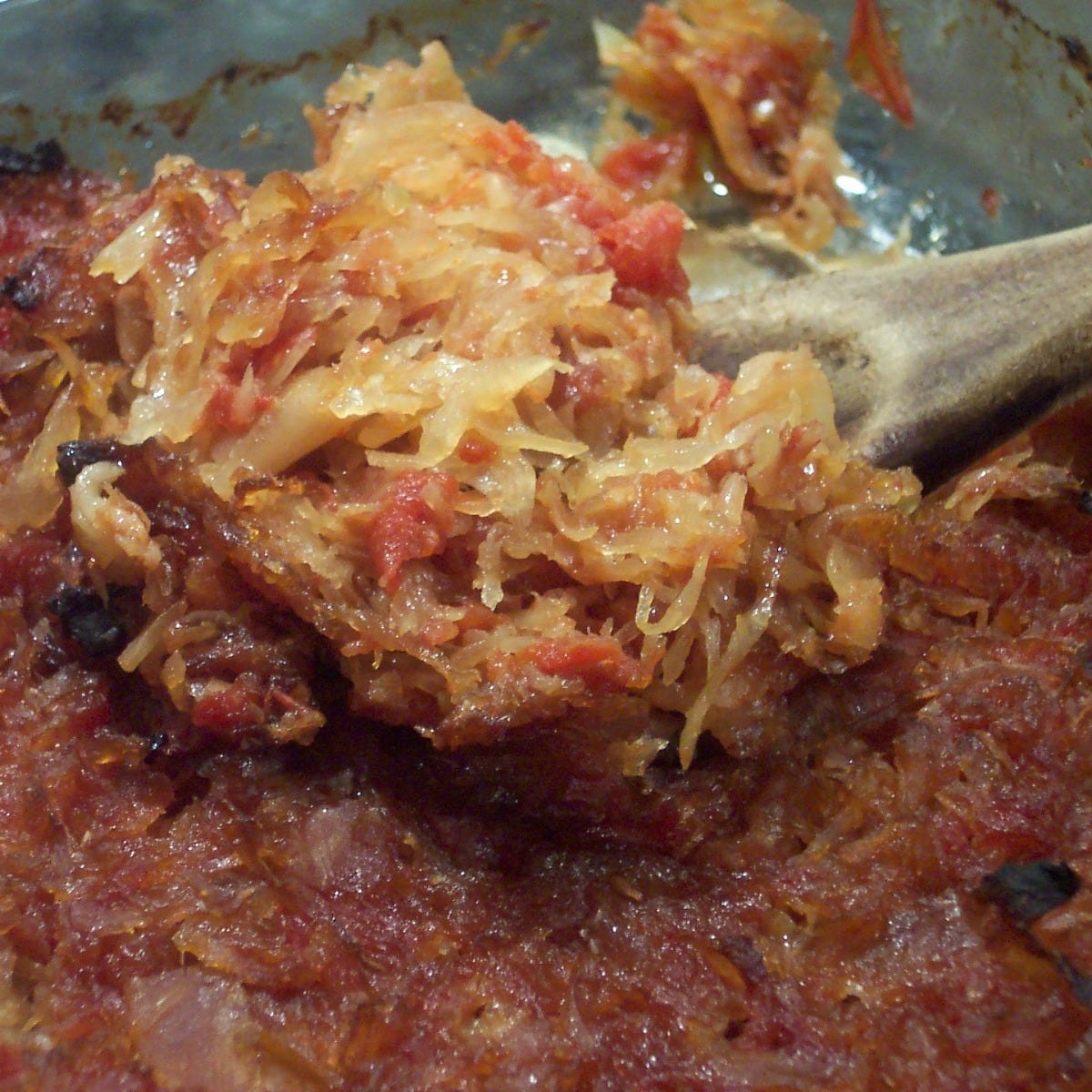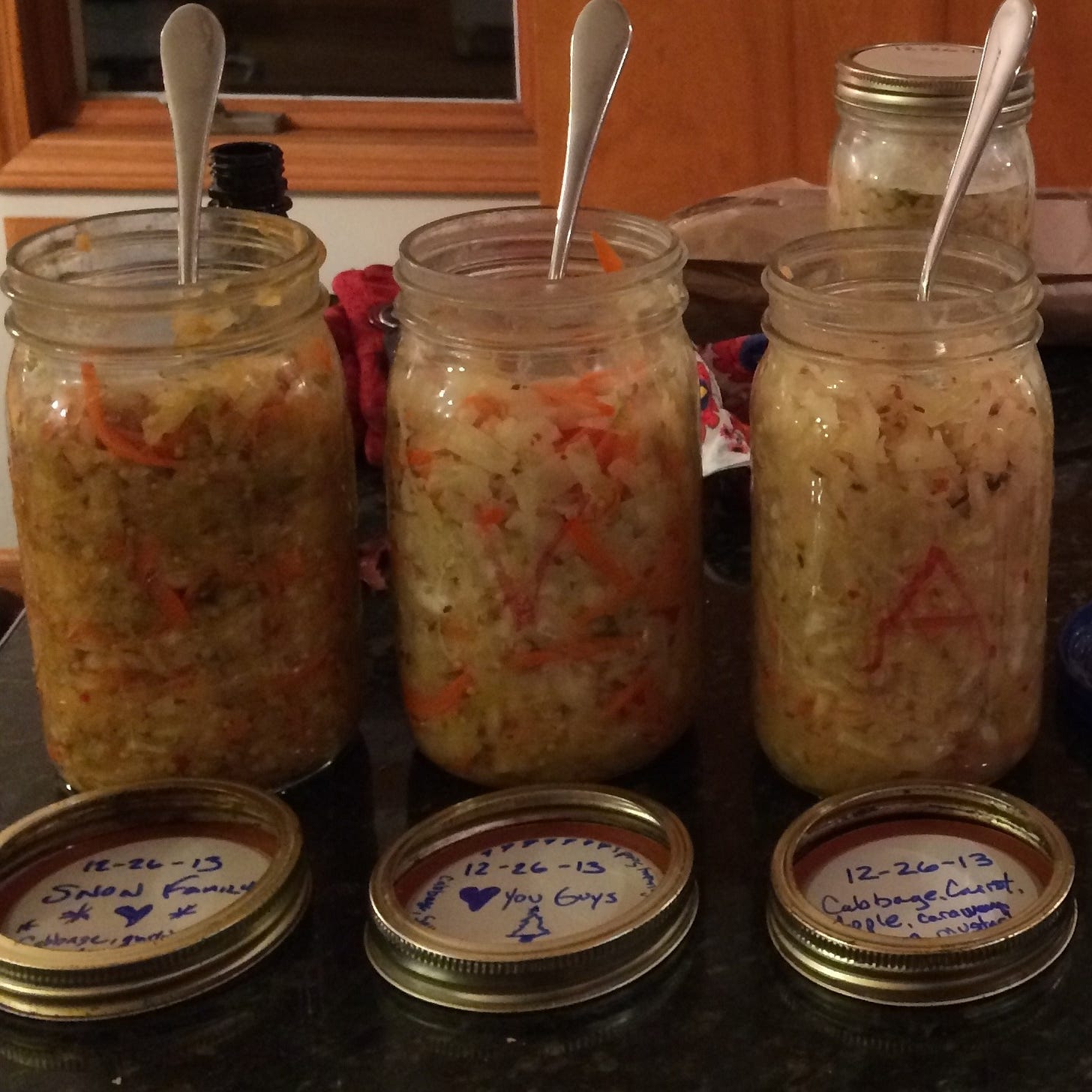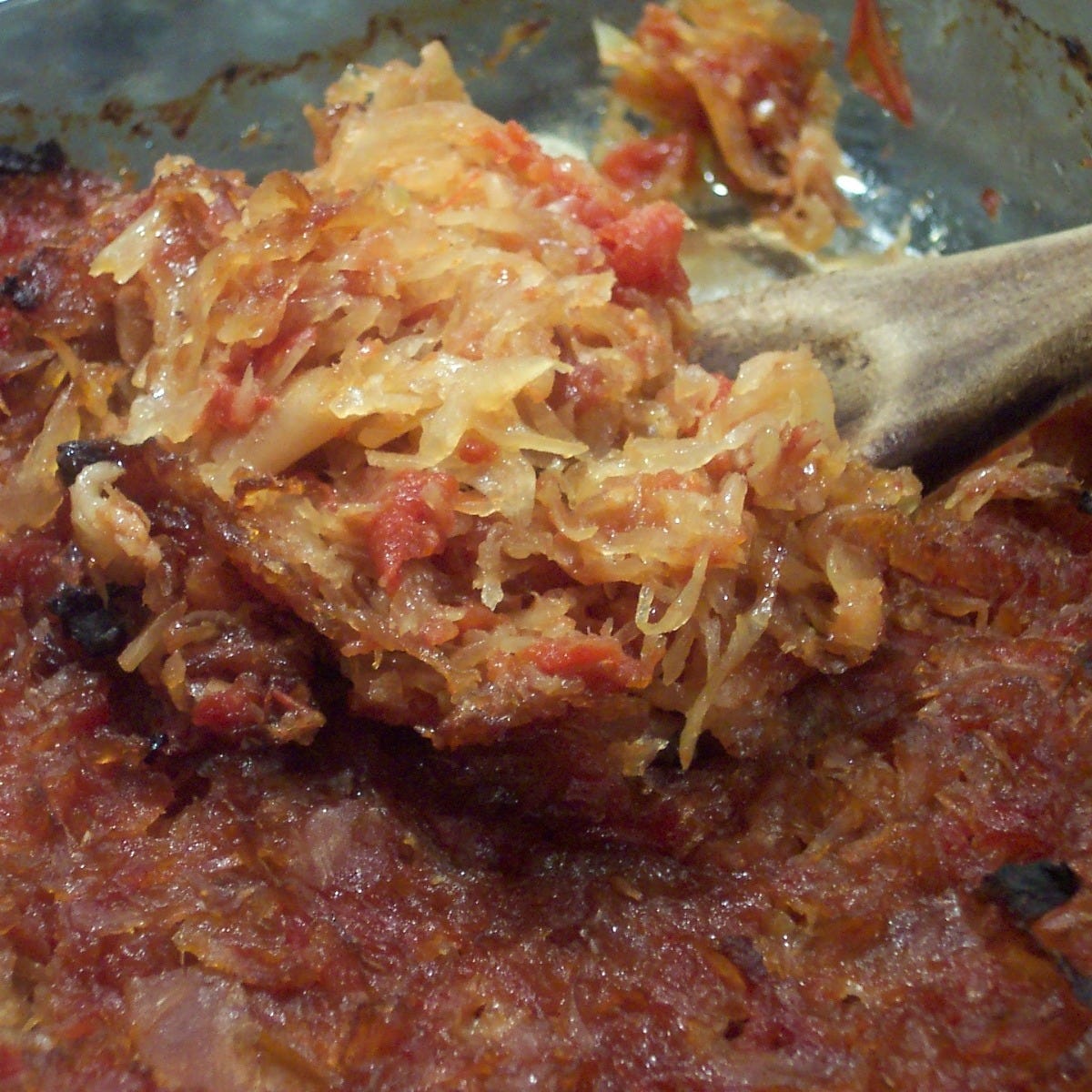Sauerkraut Dreamin'
Some are dreaming of the beaches in Florida, but I am dreaming about the sauerkraut that I missed on New Year’s Day

This year is already off-kilter for me, threatening to spin even more askew. I missed my pork and sauerkraut on New Year’s Day. I also missed making Hoppin’ John, my two good luck charms for the year. I had been traveling on NYE and NYD down to Frederick, MD, to see the mural my sister-in-law Barbra and brother Geoff installed in their backyard.


On NYE, Geoff and I went to the Common Market in Frederick for pre-made crabcakes, which served us well before we watched the Penn State football game. The next day, I left, planning to catch up on a piece of pork and a bag of kraut between Frederick and State College. But I never did.
By the time I got back, I was too tired to shop, and my visitors who had stayed behind, artist Carolyn and her husband Jeff Kerr, from New York City, were interested but not excited about my quirky Eastern European/Pennsylvania Dutchie/Southern traditions with porcine punch. They would have partaken, but it’s not their thing. They are easy; they had Carolyn’s homemade granola that night, and I had cheese and crackers once I realized I had missed dinner.
But now, the missing sauerkraut is all I can think about.
Sauerkraut is not a mainstay of my diet, but I do enjoy it every January 1st with Hoppin’ John on the side, cornbread, and mashed potatoes. But maybe it was better to delay the tradition until I get back to Wyoming next week because I saw a post on the Foodies of State College Facebook page where someone was longing for Herwig’s sauerkraut and Bernd Brandstatter generously shared his recipe. The Austrian restaurant in State College that closed in 2018 has many bereft former customers yodeling in the alley like Brandy used to do, who sorely miss their down-home specialties.
Here's the recipe from Bernd. It’s cryptic, but there is enough information to recreate their signature dish. Do not fear saturated fats and remember Herwig’s motto: “where bacon is an herb.”
Bernd Brandstatter’s Recipe for Herwig’s Sauerkraut
Shared on the Facebook site “Foodies of State College”
Pork cracklings in a pot, sweat down onions and garlic. Deglaze with beer (I like pilsners, but any lager will do)
Add juniper berries, bay leaf, granulated garlic, s/p, and caraway seeds
Add well-washed kraut (should not taste sour)
Add pork/beef or chicken stock or veg
Cook for the next couple of hours. Once it gets a lovely golden color, add in a cooked roux (we used bacon fat and flour) just enough to make it creamy.
This original article ran in the Centre Daily Times in 2003 when I was working in the Foods Lab at Penn State. I was always in my office before the semester started, preparing the manual and organizing the lab for the incoming students.
This time of year, it is quiet in Henderson Building, located in the heart of the Penn State campus. The classrooms are dark, and many of the offices are at least dim. But there are some signs of life—like the smell of sauerkraut at lunchtime.
It seems many folks brought in leftovers last week from their New Year’s Day feast of pork and sauerkraut, the meal that ensures luck in the coming year. And those of us who enjoy the tradition help guarantee good health thanks to the many nutritional benefits of this time-honored food.
The word sauerkraut derives from the German term for “sour cabbage.” Its first recorded use dates back to the 7th century BCE, when Chinese laborers were fed a cabbage dish similar to today’s ‘kraut to maintain their strength while building the Great Wall of China. This Chinese sauerkraut, made by combining shredded cabbage and rice wine, traveled via the Tartars and their emperor Genghis Khan to Eastern Europe and eventually to Germany, Alsace-Lorraine, France, and the Celtic provinces.
The ancient Egyptians, Greeks, and Romans were all big cabbage enthusiasts. Circa 200 BCE, the Roman statesman Cato advised anyone planning to “drink deep” at a banquet to fortify first with cabbage seasoned with vinegar. Egyptians cautioned to start a meal with raw cabbage and cabbage seeds to maintain sobriety. The standard hangover cure for the ancient world was to eat more cabbage. No surprise in this day and age that the one meal of the year where sauerkraut dominates comes after the one officially sanctioned night of revelry—New Year’s Eve.
But sauerkraut need not be limited to occasions of excess. One of the valuable cruciferous vegetables that supply protection in the form of phytochemicals called indoles that inhibit cancerous tumors of the breast, stomach, and colon, sauerkraut can be included in the diet frequently, as long as you are not on a sodium-restricted diet. Nutritionally speaking, it is fat-free and a good source of Vitamin C, iron, and potassium. Because cabbage is 93% water, a cup of sauerkraut contains only 32 calories. Rinsing the sauerkraut in water greatly reduces the sodium content.
Though today we can buy cabbage year-round at the grocery store, it was not always the case. Ways to preserve the vegetable that did not rely on modern methods of refrigeration and transportation included salting and pickling. Dry-salting is the method used to cure cabbage, Brassica oleracea capitata, and turn it into piquant sauerkraut.
Curing or preserving with salt is not limited to vegetables. Small herring that run in the spring and summer are cured with salt to make anchovies. With either fish or cabbage, thin pieces of the food are layered with salt to draw out their juices. In the case of cabbage, the juices rendered from the leaves form a brine that prevents spoilage, while benign microorganisms thrive. Bacteria convert the plant sugar into lactic acid, which adds a tasty, astringent flavor. This miracle of fermentation must be carefully monitored and done in a controlled temperature environment of about 65-70° F. Lower temperatures inhibit the fermentation, and higher temperatures cause the process to go out of control.
In the process of making sauerkraut, finely shredded cabbage is layered with Kosher salt (because it is pure,) in the proportion of 2 teaspoons of salt to one pound of cabbage. The cabbage must stay submerged in the brine, so a weight is placed on top to keep it from floating. As fermentation develops, carbon dioxide appears on the surface as bubbles that need to be skimmed daily for about three weeks. When this frothing has stopped, the sauerkraut can be refrigerated to keep for 6 to 9 months or can be heated and hot processed for longer storage. A recipe for making sauerkraut is the last recipe in the tenth edition of “Joy of Cooking.”
Or here is an easy one to make a small batch yourself. It’s not too late to climb onto the Good-Luck-in-the-New-Year bandwagon!
This amount makes about 2 cups of sauerkraut that should ferment for a couple of weeks at a cool temperature, about 55 degrees. Higher temperatures will cause the fermentation to go more quickly.
A Small and Quick Batch of Sauerkraut
1 pound cabbage, shredded or chopped ( 4 cups, one-quarter of a medium-sized head of cabbage)
1 carrot, cut into slivers or grated
2 cloves garlic, minced
2 teaspoons sea salt
1/4 teaspoon of caraway seed, hot pepper flakes, peppercorns, or other seasonings of your choice
One clean quart-sized Mason jar with a wide mouth
A plastic lid will weigh down the vegetables so they stay submerged in their own liquid and no air can get in. A small plastic bag filled with water works well and fills every crevice of the jar.
Slice the cabbage into fine shreds and prepare the carrots and garlic. Toss all the vegetables in a large bowl and sprinkle on the salt. Vigorously massage the salt into the vegetables. This bruising of the vegetables allows the salt to penetrate the cells and draw out the water which permits the fermentation to begin. Bacteria in the air, on the cabbage and on your clean hands initiate the microbial transformation.
Pack the kraut into the clean jar pressing firmly. You will have about 2 cups, with a layer of liquid on top. The vegetables must stay under the liquid, so fasten a plastic lid that keeps them submerged or fill a plastic bag with water (or brine if your bag may leak) and put a loose-fitting lid on the top. Place somewhere cool for three weeks until the kraut is fully fermented. Refrigerate to stop the action and enjoy as a healthy condiment.
And here is a very easy sauerkraut casserole dish that is sweet and sour and delicious.
Candied Sauerkraut with Bacon and Tomatoes
Makes about 8 cups
1 can (27 ounces) sauerkraut
1 can (28 ounces) chopped tomatoes
1 cup dark brown sugar
8 slices uncooked bacon, diced
Preheat the oven to 325° F. Combine all the ingredients in a large bowl and toss together to combine. Place into an ungreased 3-quart shallow glass or ceramic baking dish (so that the liquids can evaporate out during cooking) and bake uncovered for 2 to 2 and a half hours until the top is browned and the sauerkraut is translucent.








